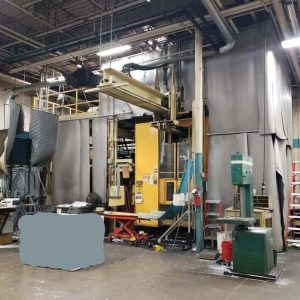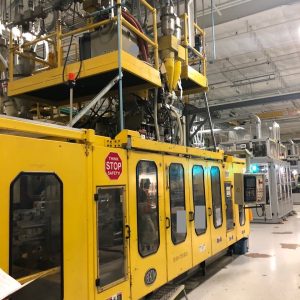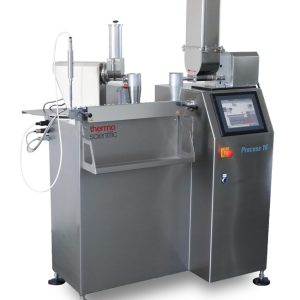Description
Ferry Industries RS4-430 Roto Molder – Year 1994
| Year | 1994 |
|---|---|
| Make | Ferry Industries |
| Model | RS4-430 |
| Ferry Industries RS4-430 | Roto Molder |
| Style of Rotomolder | Multiple Ind. Arm |
|---|---|
| Number of Arms | 4 |
| Type of Arms | Straight Arms |
| Max Swing Diameter | 181” / 165” |
| Max Load – Straight Arm | 5,000 lbs |
| Space Required (L x W x H) | 69’ x 50’ x 21’ |
| Burn Capacity | 5,600,000 BTU/hr |
| Controller | PLC |
| Water Cooling | Spray Mist |
| Electrical Requirements | 480v – 3 ph – 200 amps |
FEATURES
| Reverse Rotation | Water Cooling – Spray Mist |
| Manuals | Under Power |
What is Roto Molder Machine?
A Roto Molder machine, also known as a rotational molding machine or rotomolding machine, is a specialized manufacturing device used in the process of rotational molding. Rotational molding is a technique for producing hollow plastic products with complex shapes, such as tanks, containers, toys, automotive parts, and more.
Here’s a general overview of how a Roto Molder machine operates:
Mold Loading: The first step is to load a mold into the Roto Molder machine. The mold is typically made of metal and has two or more halves that form the shape of the desired product when joined together.
Material Loading: The machine is then loaded with the appropriate polymer material, usually in powder or granule form. The material can be a variety of plastic resins, including polyethylene (PE), polypropylene (PP), polyvinyl chloride (PVC), or others, depending on the desired properties of the final product.
Heating: The Roto Molder machine begins to rotate slowly while heating elements are activated. The rotational motion ensures uniform distribution of the heated material inside the mold. The heating elements gradually raise the temperature inside the machine and melt the plastic material.
Coating: As the plastic material melts, it coats the inner surface of the mold due to the centrifugal force generated by the rotation. The mold continues to rotate until a predetermined thickness of the plastic coating is achieved.
Cooling: After the desired thickness is reached, the heating elements are turned off, and the mold is cooled. Cooling can be achieved through a variety of methods, such as air cooling, water cooling, or a combination of both. Cooling solidifies the plastic, allowing it to retain the shape of the mold.
Mold Opening and Unloading: Once the plastic has cooled and solidified, the mold halves are separated, and the finished product is removed from the Roto Molder machine. Any excess plastic material, known as the “flash,” is trimmed off, leaving behind the final hollow plastic product.
Roto Molder machines are available in different sizes and configurations to accommodate various product sizes and production requirements. They are commonly used in industries such as automotive, packaging, construction, and toys, where the need for large, hollow plastic products with complex shapes is prevalent.
Rotational molding offers several advantages, including the ability to produce large, seamless, and structurally strong products. The process also allows for design flexibility, as intricate shapes and undercuts can be achieved without the need for additional assembly or joining processes.
It’s worth noting that while the above steps provide a general overview of the rotational molding process, specific machine designs and variations can exist based on the manufacturer and the desired application.








